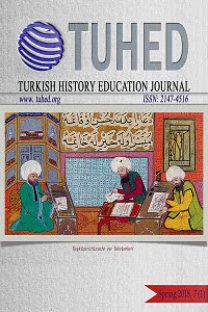İLKOKUL DÜZEYİNDE TARİH ÖĞRETİMİ
Tarih öğretimi, Amerika'da eğitimin hikâyesinde değişik dönemlerde önem kazanmış değişen düşünme modellerini yansıtmaktadır. Örneğin, eğer hâkim düşünce havası ‘yurtseverlik’ ise, o zaman tarih öğretimi büyük ölçüde bunu yansıtmaktadır. Eğer, hâkim düşünce modeli ‘dünya'yı anlama’ ise, o zaman bu fikir ilkokul programlarında azami önemi üstlenmektedir. Programa yön veren örgütsel ve kavramsal çerçevelerden söz edildiğinde, fikirler vurgusu ‘interdisipliner’ ya da ‘toplulaştırıcı’ çerçevede toplandığında, o zaman sonuç, pek çok bilginin, ‘Sosyal Bilgiler' ya da ‘Sosyal Bilimler’ olarak (Genellikle ‘Sosyal Bilgiler’ terimi, ilkokul düzeyinde kullanılır. Fakat, pek çok biliminsanı, ‘Sosyal Bilgiler' ya da ‘Sosyal Bilimler’ terimlerinin hangisinin daha kusursuz olduğu ve bundan dolayı her bir terimin temsil ettiği iki ayrı sorgulama tarzı olup olmadığı konusunda aynı fikirde değildir.) adlandırılan genel bir konu alanı ya da disiplin altında birleştirildiği bir çeşit örgütsel mihverler olmaktadır.
Anahtar Kelimeler:
Tarih öğretimi, ilkokulda tarih öğretimi
___
- American assocation of school administration (1954). educating for american citizenship, thirty-second yearbook, Washington, D.C.: National Education Association. American council of learned societies and the national council for the social studies (1962). The Social studies and the social sciences, New York: Harcourt, Brace &the World.
- Arnoff, M. (1964). Adding depth to elementary school social studies. Social Education, XXVIII, (October), pp. 335-336.
- Bruner, J. S. (1963). The Process of education. Cambridge: Harvard University Press.
- Carr, E. R. (1965). The Social studies. New York: The Center for Applied Research in Education. Dewey, J. (1916). Democracy and education. New York: Macmillan Company.
- Ford, G. W. and Pugno Lawrence, eds. (1964). The structure of knowledge and the curriculum. Chicago: Randi McNally and Co.
- Gomez, S. (1959) Competencies, content and experiences in the social studies. grades K-8. Glassboro: Glassboro State College.
- Hebb, D. O. (1958) Introduction to psychology. Philadelphia: Saunders.
- The History program in the middle public elementary schools (1963), Mass: Middleton Public Schools.
- Hullfish, H. G. and P. G. Smith (1961). Reflective thinking: The method of education, New York. Dodd, Mead and Co.
- Joyce, B. and C. Weinburg (1964) Using the strategies of sociology in social education. Elementary School Journal, LXIV (February), pp. 265-272.
- Massialas, B. G. and J. Levin (1964) Teaching social studies through discovery. Social Education, XXVIII, November, pp. 384-387.
- Melzack, R. and W. R. Thompson (1956). Effects of early experiences on social behavior’. Canadian Journal of Psychology, X, November, pp. 87-91.
- National society for the study of education (1957). Social studies in the elementary schools, fifty-sixth yearbook, University of Chicago Press.
- Pritzkau, P. T., (1959). Dynamics of curriculum improvement. Englewood Cliffs, N. J.: Prentice-Hall.
- The Scholars look at the schools: A report of the disciplines seminar (1962). Washington, D.C: National Education Association.
- Smith, R. O. and C. F. Cardinell (1964). Challinging the expanding environment theory’, Social Education, XXVIII, (March), pp. 141-143.
- Social Education (1965), XXIX, (May)
- ‘The Social studies revolution’ (1965) The Grade Teacher, LXXXIII, No:2, (October).
- ISSN: 2147-4516
- Yayın Aralığı: Yılda 2 Sayı
- Başlangıç: 2012
- Yayıncı: Ahmet Şimşek
Sayıdaki Diğer Makaleler
AHMET REFİK ALTINAY'IN BÜYÜK TÂRİH-İ UMÛMÎSİNİN GİRİŞ BÖLÜMÜNÜN OSMANLICA ÇEVİRİSİ
SÖZLÜ TARİH YÖNTEMİNİN 4. SINIF DÜZEYİNDE ETKİLİLİĞİ
MİLLÎ TERBİYE HEDEFLERİ - Reşit
AMASYA ÖZELİNDE TÜRK KADINININ TARİH ALGISI ÜZERİNE NİTEL BİR ÇALIŞMA
Gönül Türkan DEMİR, Emine ALTUNAY ŞAM
İLKOKUL DÜZEYİNDE TARİH ÖĞRETİMİ
GEÇ OSMANLI ve ERKEN CUMHURİYET DÖNEMİ ÖĞRETİM MATERYALLERİ: TARİH ve YURT BİLGİSİ DERSLERİ
